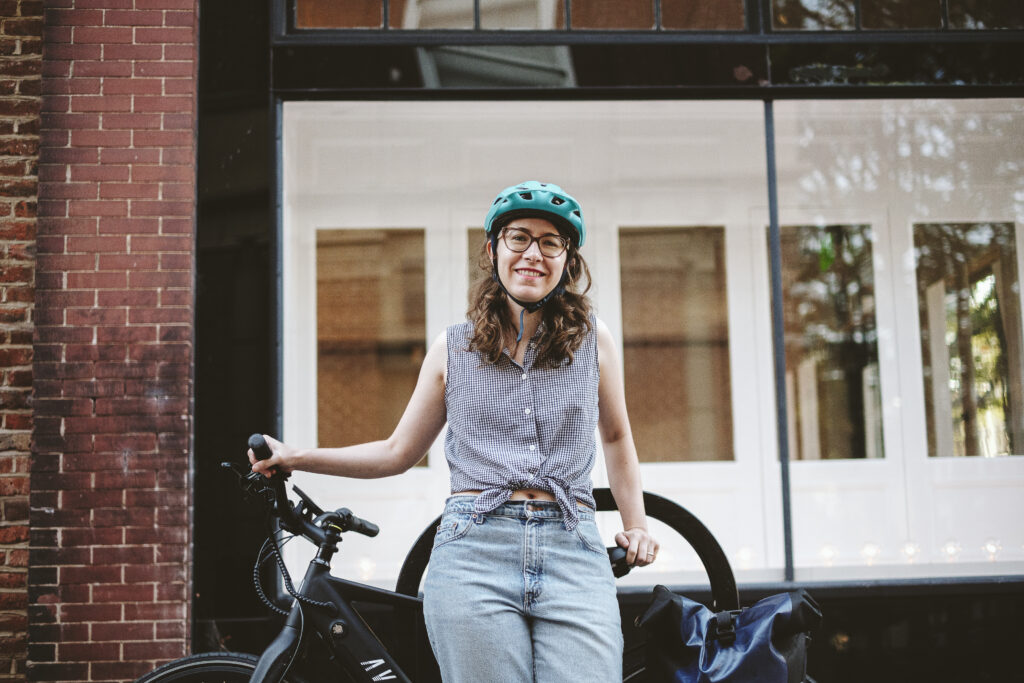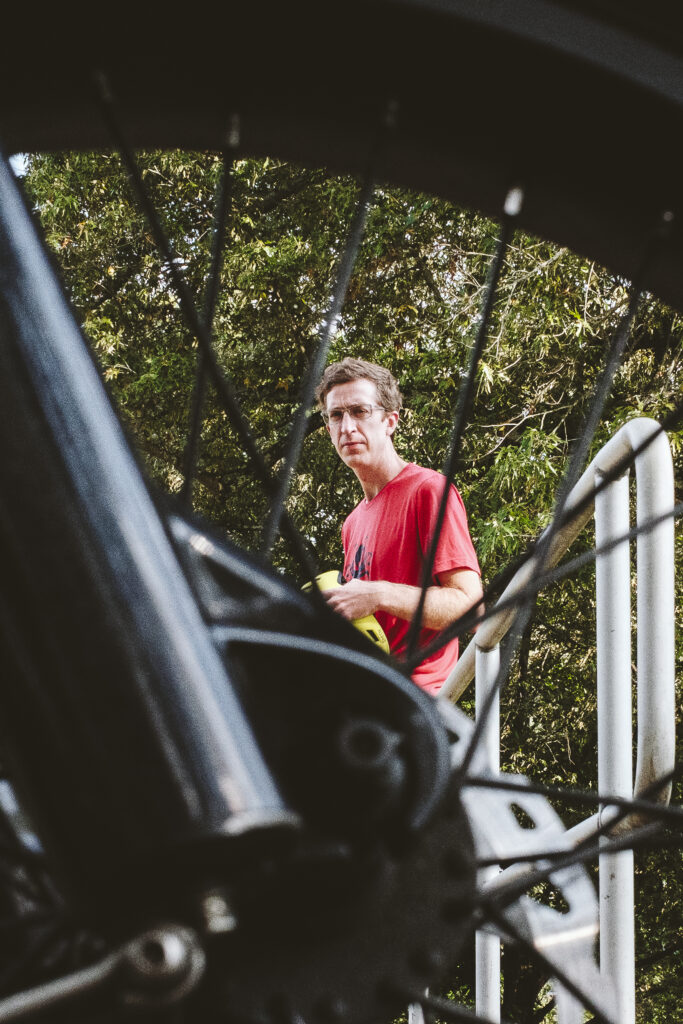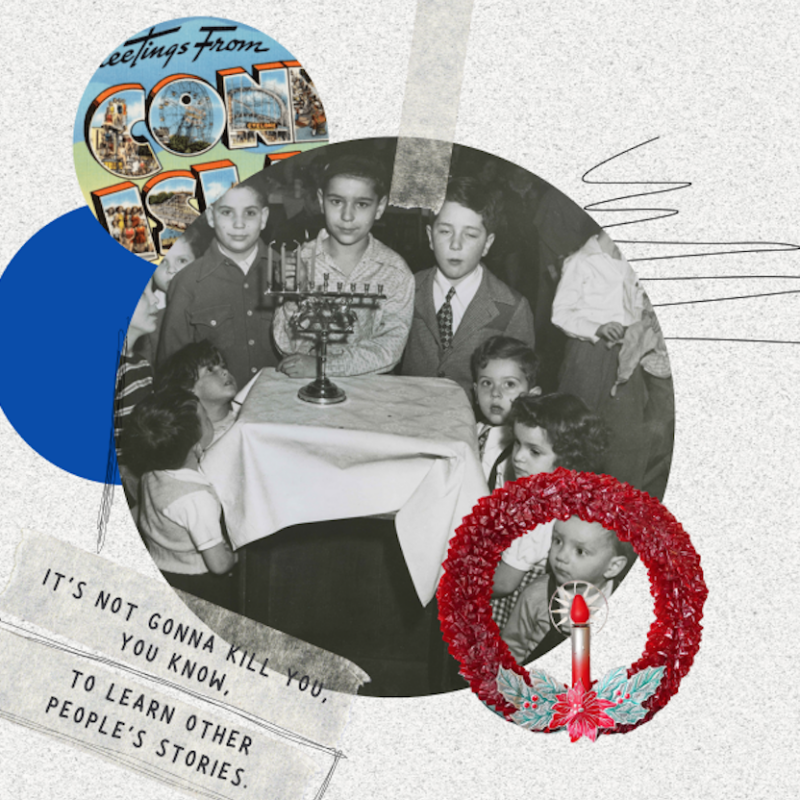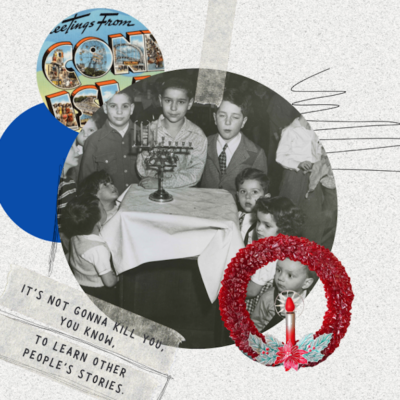A single car no longer sufficed. Kevin Driscoll, his wife, and their young daughter needed another way to get around. But instead of a second car, they chose a different set of wheels.
“I debated a long time on getting an e-bike because it was kind of a big purchase,” says Driscoll, an associate professor at the University of Virginia. But he met friends who’d been using their battery-powered, motor-assisted bikes to zip around town. They knew mechanics at a local shop who could service those bikes. “That gave me a lot of confidence about buying it.” And when Driscoll heard about a cargo bike for sale—at the time, an ideal configuration for carrying his daughter—he took the plunge.
Roughly two years later, Driscoll has no regrets. “It’s genuinely more fun to ride the e-bike to do something than to ride in the car.”
In Charlottesville and cities across the country, the growing popularity of e-bikes has led more families to go “car-light,” replacing one or both of their cars with a two- or three-wheeled alternative. Locals who’ve made the switch say their e-bikes make a faster, more pleasant, and less expensive way to get around town—provided you can accept a few key trade-offs.
These things go in cycles
PeopleForBikes, a bicycling industry group, surveys U.S. bike users annually to see how they’re using those wheels. Liam Donoghue, an Esmont resident and senior research manager for the group, says that it doesn’t currently have hard data on families going car-light. But results in its recent surveys suggest that more people are using bicycles for more purposes.
“Riding for transportation is up in the last 10 years,” Donoghue says, “even if riding only for transportation isn’t.” Data from the 2024 PeopleForBikes U.S. bicycling participation survey shows that the percentage of respondents who used bikes only for transportation—as opposed to recreation—stayed roughly constant, from 8 percent in 2014 to 2018 to 9 percent in 2024. But the combined share of people who reported using bikes for transportation alone, or for both fun and transportation, climbed from 44 percent to 54 percent in the same time frame.
Another PeopleForBikes survey from 2024 shows increases in respondents using their bicycles for commuting, from 14.6 percent in 2021 to 18.3 percent in 2024, and running errands, which rose from 13.1 percent to 16.2 percent in the same period.
“Obviously neither of these suggests a single person traded a car for a bike or bought a bike instead of a car,” Donoghue says. “But it does show that riding for utilitarian reasons is on the rise.”
Pedaling solutions
“We all default to, well, a car is what’s going to get me there,” says Matthew Gillikin, a speech therapist at UVA Hospital and co-chair of the advocacy group Livable Cville. “Especially once you realize how expensive it is to have a car, you start to think a little differently.”
“E-bikes felt like they offered a lot of advantages over a car,” says Sadie Van Vranken, “and we felt confident we could still get where we needed to go and accomplish our regular errands without a car.”
In July 2023, Van Vranken, a teacher, and her husband, James, an Albemarle County planner, traded their 17-year-old car for a pair of bikes, including a cargo bike big enough for their weekly grocery haul. “The cargo bike has proven to be an amazing fit,” Sadie Van Vranken says, noting that it’s carried “everything from Christmas trees to suitcases.”
James Van Vranken says he and his wife “no longer have to think about parking. There’s always a bike rack or a pole close to our destination, and it’s almost always closer than the nearest car parking.”
With a car, the Van Vrankens say they filled their gas tank once a week. Now, 3,000 miles on the cargo bike later, they rent a car roughly twice a year for trips out of state or to the airport. With an energy meter borrowed from the local library, they calculated that “we spend less than 1 cent per mile to charge the bikes,” James Van Vranken says. “It’s given us a significant boost in disposable income, and means we know we can easily save to buy a replacement vehicle without going into debt.”
Gillikin says his family got e-bikes to make sure they could get their children to various activities and appointments without needing to climb in the car. “In 45 minutes, I’m going to take my middle kid to soccer practice on the e-bike over in Belmont,” Gillikin says during a phone interview. “And my wife’s off at [Charlottesville High School] right now in a meeting with the car. If she’s not back in time, it’s totally fine, because I’ve got the bike to take him.”

Biking’s bountiful benefits
Claire Denton-Spalding, a consultant, has what she calls “a car and a half. One car that is good, and another car that’s my parents’ 1999 Toyota Sienna,” which she occasionally uses to haul larger items. She purchased an e-bike in summer 2022 to get around the city.
She recalled an evening last summer where, on a whim and a free night, she grabbed dinner on the Downtown Mall, biked to Riverview Park to walk the trail, and then cycled home. Denton-Spalding says the bike gives her more flexibility than a car: “I love just being able to make decisions on the fly while biking.”
MC Forelle, a UVA assistant professor, and their spouse Patrick Davison, research director for a nonprofit, say biking around is equally great for their 6- and 4-year-old children. “They’re looking around, and they’re experiencing sunshine and wind and sometimes talking to passers by,” Davison says. “In the car, it’s always kind of the same, like, ‘Turn on this song and give me a snack.’”
“They yell at every person on the sidewalk they see,” Forelle adds, “which is really cute.”
“I get such a trip from hearing them squeal with joy,” Davison says. “They just have so much fun riding the bike. Even when I’m tired, that pushes me, just to know that they are getting so much out of it, too.”
With limited parking and hard-to-get permits on UVA Grounds, Forelle says their e-bike also saves them time and money at work. Rather than paying for a spot in a distant lot, they can ride directly to their office and secure their bike at the rack just outside.
Davison says that for he and his spouse, using e-bikes is “a calculation about putting off the purchase of a second car” to supplement their small, 12-year-old Chevy. The longer they can be “two adults who can go in two different directions and do two different things, despite only having one car,” the more they can avoid a monthly car payment. “We’ve never thought of our [e-bikes] as a car replacement,” he says. “We have thought of ours as a car extension.”
Road rules
None of the car-light families in this story described e-biking as a one-size-fits-all solution. Many noted the weather’s role in whether they take a bike or a car. The Van Vrankens, who entirely replaced their car with e-bikes, invested in “lights, rain gear, gloves, and balaclavas” for cycling in any condition.
“That’s the thing about cars,” Forelle says. “They do get you where you need to go, regardless of what the weather is, regardless of whether you have a cold or you hurt your knee or whatever.”
But while their opinions of drawbacks varied, every car-light family we interviewed had one concern in common.
“I totally understand why people would not feel comfortable biking around Charlottesville right now,” Gillikin says, “because we don’t have good bike infrastructure.”
“I’m a pretty experienced biker,” Denton-Spalding says. “Even for me, some of these streets in Charlottesville feel extremely dangerous. I bike up and down Fifth Street and I’ve been buzzed by cars. I’ve seen cars in the bike lane.” She suggests the city should build more protected bike lanes, like the one it plans to add on Fifth Street by spring 2026.
Many of the car-light families we talked to described certain roads where they simply didn’t feel safe, and mentioned planning routes carefully in advance until they grew more comfortable getting around on their bikes.
“You can be as safe as you want,” Forelle says, “but there are some drivers in Charlottesville who are going to make themselves your problem no matter what.”
The White Line, an organization promoting safer roads, tracks the number of pedestrians and cyclists killed by cars. Between 2001 and 2023, the site reports two cyclist deaths in the Charlottesville area—one in 2010 on West Main Street, and another in 2021 on Ivy Road west of the city.
Gillikin says making the city friendlier for bikes would benefit more than just cyclists. “Good bike infrastructure is good infrastructure for people with mobility devices and people with power wheelchairs,” he says. “I think it can be good infrastructure for people pushing strollers or pushing someone in a wheelchair around.”
“If you build safe bike infrastructure,” Denton-Spalding says, “people will start using it.”

Happiness on two wheels
Going car-light likely isn’t the right move for everyone. “I think a lot of the stuff that makes it true for us to be a car-light family comes with a fair amount of privilege,” Davison says, acknowledging that the flexibility that lets e-bikes work for him and Forelle might not hold true for others.
Most commuter e-bikes cost between $1,000 and $3,000; cargo bikes can run $6,000 or more. Given the cost, many of the families we interviewed suggested that people interested in going car-light first borrow a bike from the Charlottesville E-Bike Lending Library, a local organization that provides free rentals for a variety of e-bike models.
And if an e-bike appeals to you enough to consider trading one or more cars for it, “get the bike first,” Davison says. “Don’t take the plunge, give yourself a safety net.” He recommended “being gentle with yourself and realizing that using your bike every day might not be something that just turns on overnight.”
Still, all the families we spoke with said they’re glad they added e-bikes to their transportation options.
James Van Vranken says he’s surprised at “how much calmer and happier I feel on a bike. There’s something about being out in the open, more aware of the environment and your surroundings, that feels relaxing and natural. Now any time I’m in a car, I feel really enclosed and quick to anger and frustration.”
“I don’t have to worry about parking,” Denton-Spalding says. “I don’t have to think about, oh, do I need to fill up my gas tank? Do I need to add like 15 other errands? I have my bike and the freedom it offers, and it feels incredible.”
Dare yourself to drive less
Week Without Driving, a national event organized by advocacy groups America Walks and Disability Rights Washington, says one-third of Americans can’t rely on a car to get where they need to go. From September 29 to October 5, the event challenges everyone who signs up to spend one week driving their car as little as possible.
Want to participate? The challenge imposes simple rules: Don’t drive yourself anywhere. If you ask someone for a ride, think about what that favor’s costing them, and what you could do to pay it back. If you grab a taxi or rideshare, imagine how that expense would fit into your budget if you had to pay it regularly. Use buses, bikes, or your own two feet to get around.
If you do have to drive, you haven’t failed, the group says. Just use the opportunity to envision how someone without that option might have needed to make do.
You can sign up for the challenge at livablecville.org/weekwithoutdriving.






